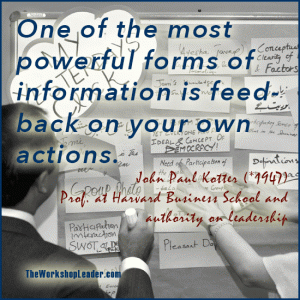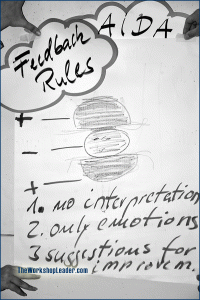One of the most powerful forms of information is feedback on your own actions.
John Paul Kotter (*1947)
Prof. at Harvard Business School and authority on leadership
Feedback is the breakfast of the champions. Only through get information how tim improve can we develop further. Thus, it is crucial to ask and to give feedback. It is vital to foster a culture of feedback as we all have a self-image that does not always correspond to the public image. Participants should be made aware that giving and receiving feedback is a vital part of self-improvement.
Here we deal with the participants mirroring each other or you give participants. With Evaluation Sheets for the whole workshop we deal in this article.
Feedback Rules
Many people are not experienced in asking and giving feedback. So, make sure you remind them to the feedback rules:
- Observations should be asked for before it is given. If the person receiving feedback doesn’t want it, then it is of no use. If someone wants to give feedback by himself the receiver has to agree.
- The person giving feedback should not interpret the reason for a particular behaviour or action (‘I think he is like that because he had a bad childhood…’) but restricts himself to describing what he observes in the other person.
- It must be concrete and not a generalisation (‘You always speak too loudly.’). An assessment of a person’s action should describe what has been seen and how the observer felt about it.
- Suggestions on ways to improve are the most helpful element of feedback. So, whenever possible the person who gives feedback should also think about how one can improve.
The Sandwich Principle
The Sandwich Principle is a recommended form of critiquing: the critique (the meat / the petty) is between positive statement. The approach looks like this:
- Positive intro, e.g. You made a wonderful and impressive presentation.
- Possible improvement, e.g. however, I felt a little overwhelmed by all the text on the slides. A few visualizations could help to grasp the information quicker.
- Positive ending, e.g. I am sure you will persuade with the combination of your confidence and the performance during the presentation any customer.
Or to remember it easier: praise-improvement-praise. If you approach a participant like this he or she won’t go in defense immediately. It’s also more the choice to take out what is useful for self-improvement.
As a workshop leader you should supervise the participants using the sandwich principle (and observing the other feedback rules) in order no to offend each other. Learning this is a life skill for every participant.
Example: I really appreciate your new approach. It’s creative and attracts attention. Nonetheless, I felt that it didn’t work out. But if you change the third element, then you would have a unique approach. I admire your courage to come up with something out of the box. I wouldn’t have dared to do it.
For you as a workshop leader there is a handout which highlights the most important points in mind before critiquing your workshop participants: Feedback Rules.
Furthermore, every participant receives the sheet filled out with the group assessment. This means he can take it home and work on it — if he or she wants to.



